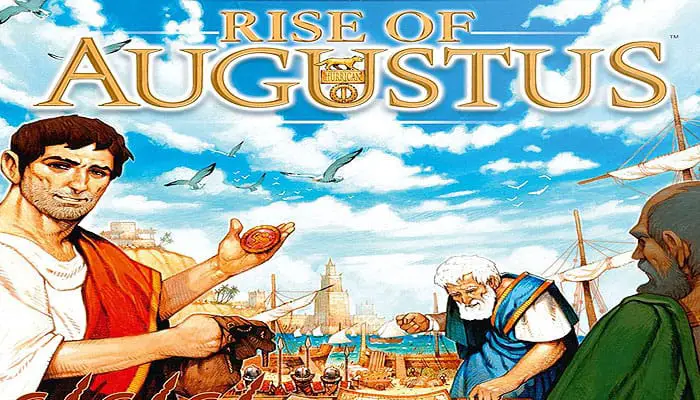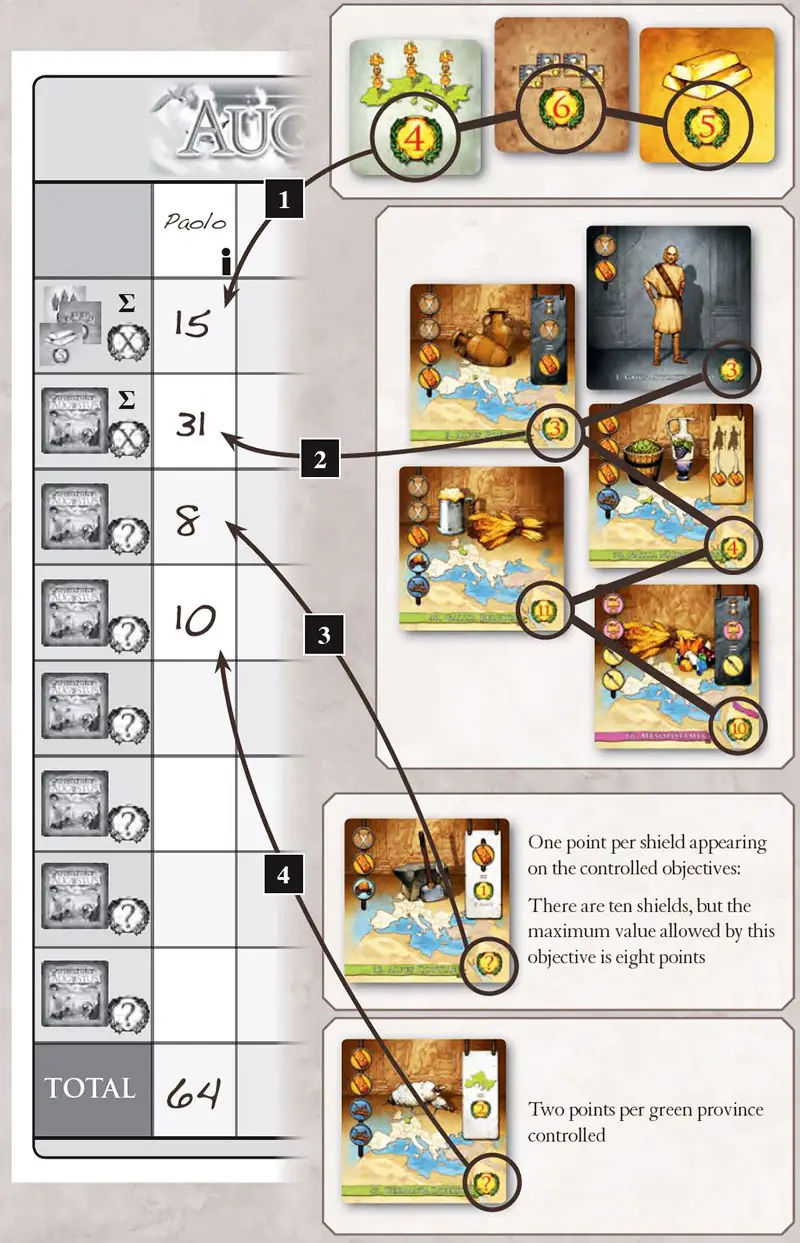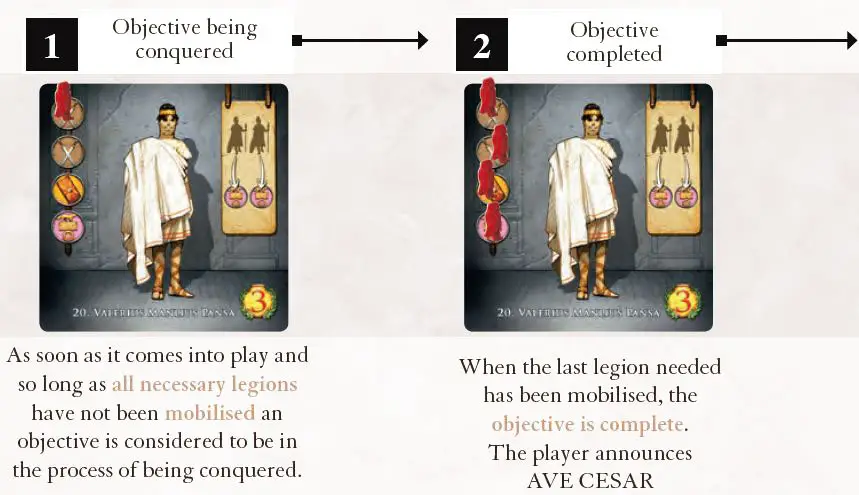
Components

- 88 objectives
- 48 legions
- 23 mobilisation tokens
- 12 rewards
- 1 cloth bag
- 1 scorepad
Overview
1. After the assassination of Julius Caesar on March 15, 44 BC., his adopted son Gaius Octavius decides to return to Rome. Very early on, he displays his ambition for political domination. In 31 BC., he is in sole control. In 28 BC., the Senate grants him the title of Princeps senatus, first member of the Senate to speak on a topic laid before the assembly. In 27 BC. he receives the title of Augustus, he whose words have the strength of prediction.
At age 36, Augustus becomes the first Roman Emperor and divides the Empire into provinces. You are legati Augusti, representatives of Augustus, and your role is to maintain the existing institutions in the provinces of the Empire.
Very ambitious, you want the title of Consul, elected each year by the Senate. For this, you need to ensure the support of the most influential senators and take control of provinces to gather as much wealth as possible. Only the most powerful among you can claim this title.
2. You start the game with three objectives to conquer and seven legions. There are two types of objective: provinces and senators

3. A town crier draws one of the 23 mobilisation tokens from the bag. He states what it is aloud and puts it on the table.
- Each token can mobilise one of the six categories of legion.
- A "joker" token allows you to mobilise the legion of your choice.

4. Depending on the tokens drawn, you can mobilise or move your legions to complete your objectives.
Your aim: Get as many points as quickly as possible because the game ends when, at the end of a turn, a player has seven controlled objectives.
5. When an objective is completed, you proclaim aloud AVE CESAR.
If several players complete an objective in the same round, each player concerned indicates their objective's number; the lowest goes first. You take back your legions, carry out any powers granted by the objective, and place it slightly to one side in the controlled objectives area, and depending on the course of the game, claim rewards.
You then choose a new objective from among the five face up in the centre of the table and put it in front of you. Then you take the first objective from the deck to bring the available objectives back up to five.
6. If other players have announced AVE CESAR, they perform the same steps, otherwise the town crier draws a new mobilisation token. And so on, until one of you has seven controlled objectives at the end of a round. You then add up the points. The player with the most points wins the game and can claim the title of Consul.
Setup

Player Aid
The player aid at the back of these rules should be readily accessible by the players.
Rewards
They are set out in a row in the center of the table.
Legions
Each player receives seven. The remainder are put to one side.
Mobilisation Tokens
The 23 tokens are mixed up in the bag.
Objectives
Five objectives are placed in the center of the table. Each player receives six chosen at random. He selects three of them and puts them in front of him, and discards the other three.
A deck is formed from the rest of the objectives, face down.
For a first game, each player receives three random objectives and puts them in front of him.
The Conquest of an Objective
The oldest player begins as town crier. He takes the bag, draws a token, states aloud what it is and puts it face up on the table.
All the players, including the town crier, can place a legion on one of their objectives, on a space of the same category as the drawn mobilisation token:
either by taking a legion from their stock,
or by moving a legion already posed. It does not matter if it was placed on another category space and / or another objective. This movement can be very useful to complete an objective.
You can only place or move a single legion for each token drawn from the bag

Joker Token

It replaces any category of legion.
After having drawn the Joker, all the mobilization tokens are put back into the bag and the player to the left of the Town Crier becomes the new Town Crier.
To complete an objective
An objective is completed as soon as all its spaces are occupied by a legion. The player then announces aloud AVE CESAR.
Then he proceeds as follows:
He removes all the legions from the objective and puts them back into his stock.
He carries out the possible power provided by the objective.
He moves the objective into his area showing the objectives under control.
If possible, and if he wants to, he claims a reward. (See § rewards) In this example he takes the wheat reward and places it in front of him.
He chooses a new objective from the five available and places it in front of him. He adds the first objective from the deck to bring the number available back up to five.

When several players announce AVE CESAR at the same time:
All the players concerned declare the number of their completed objective. Whoever has the lowest number begins. Then each player in turn, in increasing order of objective number, performs all of steps 1 to 5 above.
Important : Completed objectives awaiting resolution are neutralized, ie they cannot be the target of negative effects of enemy red objectives.
If, through the power of his objective, a player has the ability to complete others, this is done immediately before moving on to the next player and without taking into account the other players' numbers.
Claim a Reward
There are three types of rewards:
- Color of objectives.
- Number of objectives.
- Control of gold and wheat resources.
A. Color Objectives
These rewards are granted automatically when a player is the first to control:
-
three objectives of the same color

-
an objective of each color (green-pink - orange - senator).

It is possible to have several rewards of this type.
B. Number of Objectives

This reward may be claimed by any player at the moment he controls the exact number of corresponding objectives (two to six) and if the reward in question is still available in the center of the table.
But note: A player can only have a single reward of this type. The reward can only be claimed when the player controls EXACTLY the number of objectives indicated. (A reward that is not claimed immediately is a lost reward for that particular player).
It is not possible to exchange a reward for another of higher value.
It is thus necessary to choose:
- take a reward when that is possible, at the risk of not being able to claim a reward of greater value later,
- wait until you control more objectives, at the risk that the desired reward is grabbed by another player in the meantime.
Note : It is impossible to lose a color or number of objectives reward. Even if a player later loses one of the objectives that enabled him to obtain a reward, he still keeps it.
C. Control Of Gold And Wheat Resources


The first player to control an objective producing gold and / or wheat will automatically get the corresponding reward. He keeps it as long as he controls more objectives producing such resources than any other player(s).
But, if a player matches him by controlling the same number of resources, he must give him the resource.
End of the Game
The game ends if a player has seven controlled objectives at the end of the round.
If several players complete an objective in the same round, they carry out the five steps as normal.
Then, each player adds up his points using the scorepad as follows:
- Total the points from rewards.
- Total the points shown on controlled objectives.
- Total the points from powers.
- Add it all together.
The player with the most points wins the game and can claim the title of Consul.
In the case of a tie, the one who controls the most senators wins.
Example of Scoring
Various Stages Of The Evolution Of An Objective
Continue Reading




